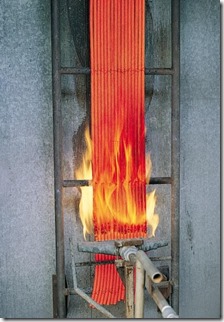Fire Resistant and Fire Retardant Cables
Fire resistant and fire retardant cable sheaths are design to resist combustion and limit the propagation of flames. Low smokes cables have a sheath designed to limit the amount of smoke and toxic halogen gases given off during fire situations.
 IEC 60332-3, BS 4066- 3
IEC 60332-3, BS 4066- 3
Test Non propagation of
fire on bunched cables Fire Rated Cables
- Flame Retardant - designed for use in fire situations where the spread of flames along a cable route needs to be retarded
- Fire Resistant (FR) - cables are designed to maintain circuit integrity of those vital emergency services during the fire
- Low Smoke and Fume (LSF) - burns with very little smoke and fumes compared to standard PVC, fumes may contain halogens
- Low Smoke Zero Halogen (LSZH) - when burns there is very little smoke and fumes (compared to standard PVC the fumes contain no halogens
- Alternative names for LSZH - LSZO (Low Smoke Zero Halogen), 0HLS (Zero Halogen Low Smoke), LSHF (Low Smoke Halogen Free)
Due to relative low cost, fire retardant cables are widely used as fire survival cables. . Fire resistant cables are often used to maintain circuit integrity of those vital life safety systems such as fire alarm and suppression services.
Flame Retardant Standards
- IEC 60332-1/BS 4066-1 - flame test on single vertical insulated wires/cables
- IEC 60332-3/BS 4066-3 - flame test on bunched wires/cables
- UL Standard for Fire Retardant Cable
- CMP (Plenum Flame Test/ Steiner Tunnel Test) - plenum rated cables meeting NFPA -262
- CMR (Riser Flame Test) - riser rated cables meeting UL1666
- CM (Vertical Tray Flame Test) - general purpose cables meeting UL 1581
- CMG (Vertical Tray Flame Test) - general purpose cables meeting UL1581
- CMX (Vertical Wire Flame Test) - restricted cables meeting UL1581
Fire Resistance Standards
- IEC 60331 - fire resistance test
- BS 6387 - fire resistance test (more stringent than IEC 60331)
Low Smoke Zero Halogen Cable
Increasingly used in public and government buildings and where there is sensitive electronic equipment (i.e. Hospitals, Supermarkets, Airports, Control Rooms & Computer Suites) these cables are designed for increased safety in the case of a fire:
- Reduction in hazardous fumes which can cause injury when inhaled
- Reduction in corrosive chemicals which can cause damage to electronics
Historically, most cables used in installations have been insulated with PVC or similar materials. In fires, these insulation materials release chlorine gas. Chlorine is a poisonous gas and a danger to people. In addition it forms hydrochloric acid when coming into contact with water. Hydrochloric acid can have devastating effects on adjacent equipment.
To overcome the problems associated with the release of chlorine gas, halogen-free cables are used. Typically a halogen free cable is made of polypropylene, which does not produce a dangerous gas or acid in fire conditions.
Cables intended to fulfil this type of function are often labelled as one of the following:
- LSZH - Low Smoke Zero Halogen
- LSOH - Low Smoke Zero Halogen
- LSF - Low Smoke and Fume
- OHLS - Zero Halogen Low Smoke
Both LSZH and LSF are used to limit smoke, fumes and halogen given off in fire conditions.
In the event of a fire, both types will emit very low levels of smoke. LSF cable will emit toxic gases while LSZH will limit the emission of these (typically under 0.5% hydrogen chloride emission). In addition to being toxic, hydrogen chloride is corrosive to equipment. The use of LSZH cables protect both people and limit the amount of equipment damage during a fire situation.
LSF is often a modified PCV with hydrogen chloride additives and while performing better than PVC will give off more smoke and fumes than LSZH. Hydrogen chloride emissions of LSF cable may reach up to 18%.
Compared with normal PVC cables and LSF, zero halogen cables have better fire retardant properties, low toxic and corrosive gas emissions and low smoke emission.
Halogen & Smoke Emission, Corrosively & Toxicity Standards
- IEC 60754-1/BS6425-1 - emission of halogen
- IEC 60754-2 - corrosivity
- IEC 61034-1/ASTM E662 - emission of smoke
- ISO4589-2/BS2863 - oxygen index LOI
- ISO4589-3/BS2782.1 - temperature index TI
- ES713 - toxicity index